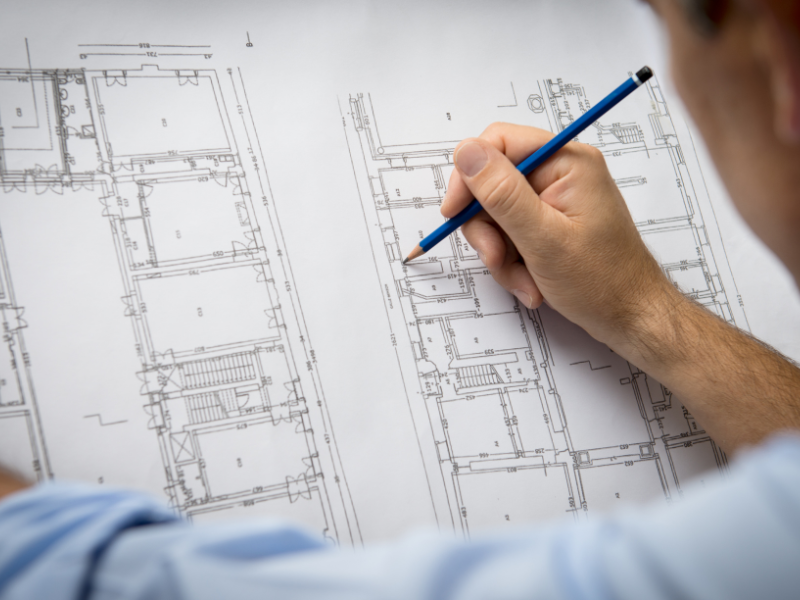Architect Portfolio Examples That Attract Clients Fast
Architect Portfolio Examples That Attract Clients Fast
Blog Article
Understanding the Diverse Occupation Paths Available for Aspiring Architect
As an aspiring Architect, you have a world of career paths waiting for you. Each path provides special obstacles and possibilities to use your creativity and technical knowledge. Whether you're attracted to traditional design or the subtleties of sustainable style, there's a niche that lines up with your interests. Comprehending these varied alternatives can shape your expert trip, but which direction will you pick to check out first?
Traditional Architecture: Designing Frameworks and structures
Conventional style concentrates on designing structures and frameworks that blend capability with aesthetic charm. Your styles can reflect social heritage, showcasing local customs while meeting contemporary demands.
You'll create skills in drafting, model-making, and site evaluation, permitting you to visualize and connect your concepts efficiently. Engaging with customers, you'll require to understand their vision and translate it into feasible styles.
In addition, constructing codes and sustainability techniques are essential in your work, guaranteeing your structures are eco friendly and secure. As you expand in your occupation, you'll discover opportunities in property, industrial, or even restoration tasks, each offering one-of-a-kind difficulties. Accepting standard style leads the method for a fulfilling occupation that admires the past while shaping the future.
Urban Planning: Shaping Areas and Public Spaces
As a hopeful Architect, you can play a vital duty as an urban coordinator, transforming how communities work and interact. By utilizing neighborhood engagement strategies, you'll ensure that locals have a voice in forming their setting. Plus, integrating sustainable style principles will certainly assist develop rooms that not just fulfill today's requirements however additionally secure the future.
Function of Urban Planners
While several may think of engineers as the single dreamers behind structures, urban planners play an essential duty fit the wider landscape of neighborhoods and public rooms. They assess land use, zoning laws, and neighborhood requires to create sustainable settings that boost quality of life. By teaming up with different stakeholders, you'll aid design parks, transportation systems, and houses that advertise social communication and access. Urban organizers also concentrate on environmental factors to consider, ensuring that developments integrate green areas and support biodiversity. Your experience in spatial design and area dynamics permits you to visualize future growth while preserving social heritage. In this essential function, you'll directly influence just how individuals experience their environments, making every project a possibility for favorable modification.
Area Involvement Strategies
Efficient community engagement strategies are important for city coordinators to ensure that the voices of residents are listened to and valued in the planning process. To foster purposeful dialogue, you should focus on open discussion forums and workshops where community participants can express their ideas and issues. Use studies and social media to get to a broader audience, making sure varied point of views are consisted of. Collaborating with local companies can enhance trust fund and assist in much deeper links. It is essential to supply clear info regarding decision-making procedures and suggested tasks, enabling locals to really feel educated and empowered. By actively paying attention and integrating responses, you'll produce rooms that show the community's needs, eventually leading to even more effective and sustainable urban atmospheres. Welcome openness and continuous dialogue for enduring influence.
Sustainable Style Concepts
When creating city spaces, integrating lasting style principles is vital for producing environments that thrive both ecologically and socially. Consider incorporating green rooms, like parks and yards, to boost biodiversity and enhance air quality.
Creating with water conservation in mind is likewise key-- consider rain yards and absorptive surface areas to manage stormwater. Involving area participants throughout the planning procedure warranties that the rooms you create meet their needs and encourage social interaction. By welcoming these principles, you'll contribute to vibrant, sustainable urban landscapes that benefit everyone.

Landscape Design: Producing Lasting Exterior Environments
As you check out landscape style, you'll discover necessary design concepts that develop lovely and useful exterior rooms. Sustainable methods play a vital role in making certain these atmospheres grow while reducing environmental impact. Plus, you'll locate a selection of occupation possibilities that permit you to make an actual distinction in exactly how individuals communicate with nature.
Style Concepts in Landscape
Comprehending style principles in landscape architecture is important for creating lasting outdoor atmospheres that balance with nature. You'll require to consider elements like balance, scale, and percentage to assure your designs really feel cohesive and welcoming. Additionally, pay focus to seasonal modifications, developing with materials that complement the environments year-round.
Lasting Practices Summary
Sustainable techniques in landscape architecture not only concentrate on appearances but also prioritize environmental health and resource conservation. You can design spaces that advertise dirt health and wellness, such as making use of organic materials and exercising permaculture principles. Eventually, these techniques assure your layouts profit both individuals and the setting for years to come.
Job Opportunities Expedition
With a strong structure in lasting techniques, landscape style supplies a selection of career paths that allow you to make a significant effect on the atmosphere. You could work as a landscape developer, producing visually pleasing and functional outdoor spaces, or focus on environmental restoration, helping to restore damaged environments. Urban planners frequently collaborate with landscape engineers to produce environment-friendly spaces in urban settings, boosting city livability. If you're enthusiastic about education and learning, think about ending up being a landscape design teacher, motivating future generations. Furthermore, you might deal with nonprofits concentrated on environmental sustainability or involve in study to innovate new methods. Each path not just forms attractive settings but also fosters a healthier planet for future generations.
Lasting Layout: Concentrating on Eco-Friendly Practices
As you discover your job in design, embracing environmentally friendly techniques can establish you apart in a competitive field. Sustainable style concentrates on creating buildings that minimize environmental influence while improving occupant wellness. By incorporating eco-friendly products, energy-efficient systems, and sustainable building methods, you'll contribute to a greener future.
Start by getting understanding of environment-friendly qualifications like LEED or BREEAM, which can strengthen your credentials. Think about exactly how natural light, air flow, and thermal efficiency can enhance design. Collaborate with engineers and environmental professionals to introduce remedies that minimize waste and conserve sources.
Don't forget the relevance of area involvement-- interesting neighborhood stakeholders can inspire styles that integrate with the environment. As clients significantly focus on sustainability, your know-how in green methods Recommended Site will certainly not only draw in jobs yet likewise meet your interest for accountable design. Accept this vital element of the occupation, and enjoy your profession grow.
Historic Preservation: Protecting and Bring Back Cultural Heritage
While you start on your building trip, think about the crucial role of historical conservation in keeping our social heritage. This field concentrates on the security and reconstruction of substantial buildings, websites, and structures that inform the stories of our past. By taking part in historic preservation, you'll assist secure the building heritage that shapes neighborhood identification.
As a historic preservation Architect, you'll assess historical relevance and examine the problem of structures. You'll function carefully with conservationists and chroniclers to assure genuine remediation methods are utilized. This profession path permits you to blend creativity with research study, allowing you to design services that respect original materials and craftsmanship.
Your job not just contributes to sustainability by recycling existing structures however likewise promotes a sense of satisfaction within communities. Welcoming this course will certainly aid you become a guardian of background, protecting the tales and aesthetic appeals that enrich our lives.
Interior Design: Enhancing Indoor Spaces
Historic preservation and interior design both share a dedication to enhancing the built environment, yet they concentrate on various elements. While historical conservation highlights keeping a framework's historic and social worth, interior style nos in on maximizing indoor rooms for performance and visual appeals.
As an aspiring Architect, you'll locate that interior design permits you to mix creativity with technological skills. You'll create spaces that not just look good yet also advertise convenience and efficiency. This field entails recognizing exactly how light, color, and products interact within a space, impacting mood and usability.
You'll function on numerous projects, from domestic homes to business workplaces, ensuring that each atmosphere satisfies the requirements of its occupants. By prioritizing customer experience, you can change insides into useful and motivating spaces, making a considerable effect on how people interact with their surroundings. Accept the possibility to enhance interior environments and shape the means people live and function.
Industrial Design: Merging Functionality With Visual Appeals
Industrial design plays an essential duty in creating products that seamlessly mix looks with functionality, making sure that what you utilize daily is not just visually attractive but also sensible. As a hopeful Architect, you can engage yourself in this area, concentrating on creating everything from furniture to customer electronics. Your job entails comprehending individual demands, materials, and producing procedures, enabling you to create cutting-edge options that enhance everyday experiences.
In industrial style, you'll frequently work together with producers, marketing experts, and designers, making sure that your styles are not just attractive however likewise feasible. You'll discover to stabilize type and function, focusing on usability without compromising design. By honing your skills in sketching, 3D modeling, and prototyping, you'll be well-appointed to bring your More Help concepts to life. This job course offers a dynamic environment where imagination meets practicality, making it a fulfilling option for engineers interested in shaping the products of tomorrow.
Often Asked Questions
What Educational Credentials Do I Required to End Up Being an Architect?
To end up being a designer, you'll require an expert degree in architecture, normally a Bachelor's or Master's. In addition, you'll need to finish a teaching fellowship and pass the Architect Registration Evaluation to exercise legally.
Are There Certification Demands for Different Building Job Paths?
Yes, there're qualification needs for various architectural paths. Architect. You'll require to pass tests, total teaching fellowships, and often go after specialized training, depending upon your picked emphasis, like landscape style, urban layout, or historic conservation
What Software Program Abilities Are Vital for Designers Today?

How Can I Gain Practical Experience While Researching Style?
You can acquire functional experience by interning at building firms, joining design competitions, offering for neighborhood projects, or working together with classmates on real-world jobs. These possibilities improve your skills and develop important links in the industry.
What Task Opportunities Exist Outside Typical Design Firms?
You can check out numerous task opportunities outside typical style firms, like city planning, interior decoration, landscape style, building administration, actual estate development, or even duties in sustainability consulting. Each offers unique challenges and benefits.
Whether you're attracted to conventional style or the nuances of sustainable design, there's a niche that straightens with your interests.When designing city spaces, incorporating lasting style concepts is essential for developing atmospheres that prosper both environmentally and socially.As you discover landscape architecture, you'll uncover important style concepts that develop stunning and useful outdoor rooms.Recognizing layout principles in landscape design is crucial for producing sustainable exterior atmospheres that harmonize with nature.In commercial style, you'll usually work together with engineers, marketers, and producers, making sure that your layouts are not only beautiful however likewise viable.
Report this page